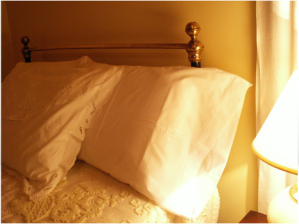If you read women’s fashion magazines regularly, like I do, you will inevitably come across mention of Clarisonic brushes and how great they are. Touted as the best way to remove make-up and truly cleanse the skin these sonic cleaning brushes have a loyal following. But do you really need to use one?
Additionally, Clarisonic says that their brush is good for all skin types and is gentle enough for people with acne and rosacea and can be used twice daily.
And how does it work exactly? This is the same sort of technology like your electric toothbrush (and indeed the company that created the Clarisonic brush first created a sonic toothbrush). The sonic frequencies from the brush create 300 movements per seconds, once again according to the company website, in order to remove make-up and dirt more efficiently from the skin. These movements also whisk away dead skin cells sitting on top of your face and this, of course, makes your skin feel softer.
But Is A Sonic Cleansing Brush Really For Everyone?
So after reading the Clarisonic website or a fashion magazine article about the brush you probably want to go out and buy one immediately. But I want to caution my readers about a few things before you spend your hard-earned money on a sonic cleansing brush.
Dr. Leslie Baumann pointed out a few interesting things about such cleansing brushes on a post on her Yahoo! blog:
… anyone with sensitive skin – and acne-prone skin is indeed sensitive – should actually avoid these vigorous scrubbing products, which can exacerbate inflammation.
Rosacea and the tendency to experience skin allergies are further indications that you should not be using an abrasive exfoliant or a vigorous cleansing brush. Similarly, anyone with very dry skin should avoid exfoliating, which may compromise an already impaired skin barrier and worsen dryness.
That is not to say, though, that facial brushes are universally bad. Resistant types in particular can benefit from more intensive exfoliation. Remember, in my skin-typing system, “resistant” is the opposite of “sensitive” – but resistant types have their own set of concerns:
Because their skin is literally thicker, they have to work a little harder to get beneficial ingredients to penetrate. And one great way to do that is by sloughing off dead skin cells before applying other products.
So if you have skin that can tolerate facial brushes, there’s no reason not to use them. Just be aware that they offer no more benefits than a good facial scrub (I love the Alchimie Forever Excimer Plus Gentle Antioxidant Refining Scrub, for example), although they may be a little more fun! When you consider some of the brushes out there, though – like Clarisonic’s Skincare Brush, the gold standard of facial brushes that retails for almost $200 – fun might not be worth the premium.
Paula Begoun has even harsher words for these brushes. Here are some highlights from her Beautypedia review of the Clarisonic cleansing brush:
| We’re not saying that Clarisonic’s brush is not a good way to clean skin. What we are saying is that it is not the only nor is it the best way to clean skin or remove makeup. Without question, it is needlessly expensive and not something anyone should go into debt for out of concern their skin is not getting clean enough. Besides, if you want to see what all the fuss is about, you can check out the similar cleansing brush system from Olay’s Pro-X brand (this retails for around $30).The only other published piece of information about Clarisonic simply described how the sonic cleansing worked to provide consistent results and help loosen debris trapped in pores due to the oscillating brush head. Sounds promising, but the piece was written by Pacific Bioscience Laboratories, the company that, you guessed it, sells Clarisonic (Source: Journal of Cosmetic Dermatology, June 2006, pages 181-183).This brush will certainly help clean skin (and for that reason it deserves a Good rating), but it won’t reduce wrinkles, pore size, or blemishes–at least not to a degree where you’ll be glad you splurged on the system. The basic system includes two brush heads (for normal and sensitive skin); a Delicate brush head is available for separate purchase (all brush heads cost $25 apiece). The Delicate brush is recommended for very sensitive skin; however, regardless of brush head chosen, I’d use caution if you’re attempting to use Clarisonic and have rosacea or sensitive skin.NOTE: If you decide to use this or any other cleansing brush on your skin, please be gentle. Overzealous usage can lead to inflammation that can hurt your skin’s healing process. Pay attention to how your skin responds and discontinue (or reduce frequency of) use if you see signs of irritation. |
|
So Should You Buy A Sonic Brush?
I think that if you wear a lot of make-up daily or have very thick and/or oily skin then investing in a sonic cleansing brush is a good idea. If you have rosacea and/or papules and pustules from acne (or from severe rosacea) then I don’t think a sonic cleansing brush is for you.
My experience with my Clarisonic Mia has been interesting. The first time I used it I was shocked by how soft my skin felt immediately after using it. But when I went to use my brush the following morning my skin turned red and felt irritated. Now I use my brush every evening, and only in the evening, with my gentle cleanser to remove my make-up and then I cleanse with my GloTherapeutics salicylic acid cleanser. I’ve wondered for a long time if I am really removing all my make-up completely at the end of the day before bedtime. There are so many make-up products, especially foundations, that are close to impossible to remove. Since I strongly believe in making sure your face is properly cleansed at the end of the day, I felt like a Clarisonic brush would be the perfect way to make sure that was accomplished. I am glad that I invested in a Clarisonic because now I feel that I am truly removing all my make-up in the evening, but having said that I am making sure that I don’t over do it with the brush as well. Even though I have oily, resistant skin I am only using my brush once a day, and I use the sensitive skin brush head for the brush.
If you own a Clarisonic brush, or one of the similar brushes, please share your experience below.
Further Reading:
Photo from clarisonic.com










Recent Comments